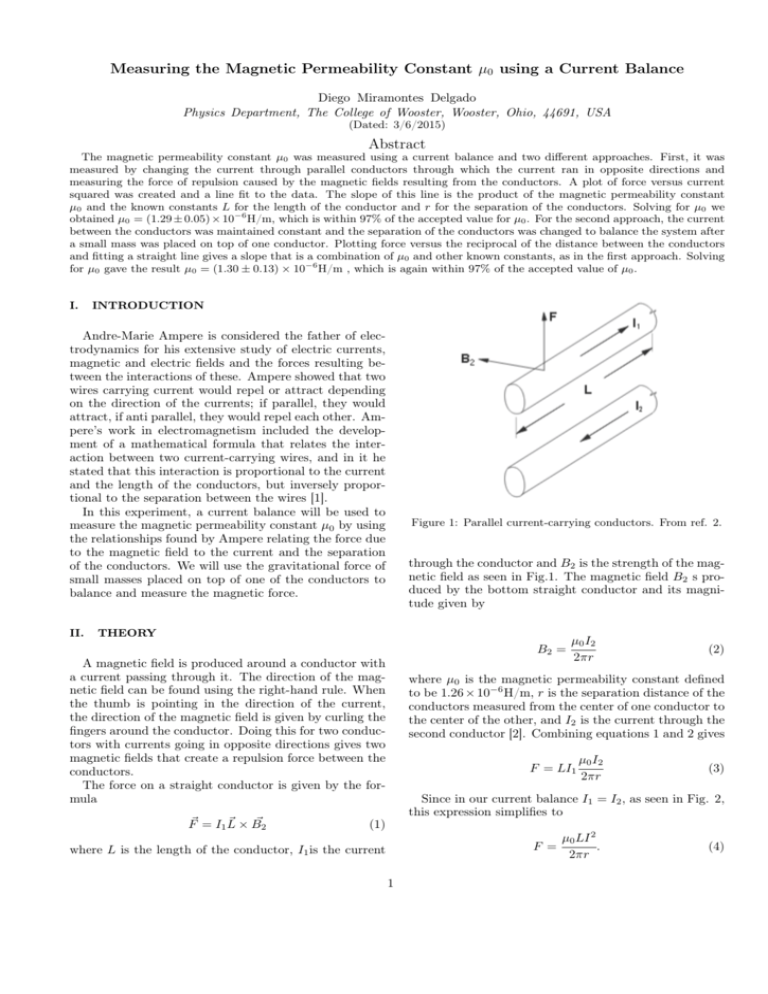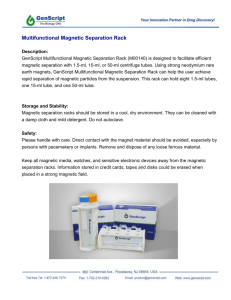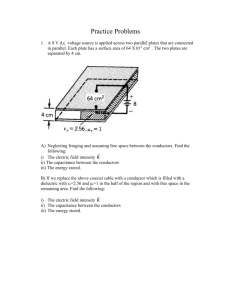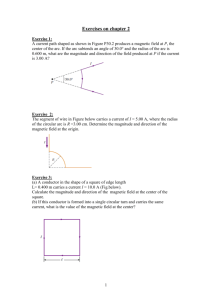Measuring the Magnetic Permeability Constant μ0
advertisement

Measuring the Magnetic Permeability Constant µ0 using a Current Balance Diego Miramontes Delgado Physics Department, The College of Wooster, Wooster, Ohio, 44691, USA (Dated: 3/6/2015) Abstract The magnetic permeability constant µ0 was measured using a current balance and two different approaches. First, it was measured by changing the current through parallel conductors through which the current ran in opposite directions and measuring the force of repulsion caused by the magnetic fields resulting from the conductors. A plot of force versus current squared was created and a line fit to the data. The slope of this line is the product of the magnetic permeability constant µ0 and the known constants L for the length of the conductor and r for the separation of the conductors. Solving for µ0 we obtained µ0 = (1.29 ± 0.05) × 10−6 H/m, which is within 97% of the accepted value for µ0 . For the second approach, the current between the conductors was maintained constant and the separation of the conductors was changed to balance the system after a small mass was placed on top of one conductor. Plotting force versus the reciprocal of the distance between the conductors and fitting a straight line gives a slope that is a combination of µ0 and other known constants, as in the first approach. Solving for µ0 gave the result µ0 = (1.30 ± 0.13) × 10−6 H/m , which is again within 97% of the accepted value of µ0 . I. INTRODUCTION Andre-Marie Ampere is considered the father of electrodynamics for his extensive study of electric currents, magnetic and electric fields and the forces resulting between the interactions of these. Ampere showed that two wires carrying current would repel or attract depending on the direction of the currents; if parallel, they would attract, if anti parallel, they would repel each other. Ampere’s work in electromagnetism included the development of a mathematical formula that relates the interaction between two current-carrying wires, and in it he stated that this interaction is proportional to the current and the length of the conductors, but inversely proportional to the separation between the wires [1]. In this experiment, a current balance will be used to measure the magnetic permeability constant µ0 by using the relationships found by Ampere relating the force due to the magnetic field to the current and the separation of the conductors. We will use the gravitational force of small masses placed on top of one of the conductors to balance and measure the magnetic force. II. Figure 1: Parallel current-carrying conductors. From ref. 2. through the conductor and B2 is the strength of the magnetic field as seen in Fig.1. The magnetic field B2 s produced by the bottom straight conductor and its magnitude given by THEORY B2 = A magnetic field is produced around a conductor with a current passing through it. The direction of the magnetic field can be found using the right-hand rule. When the thumb is pointing in the direction of the current, the direction of the magnetic field is given by curling the fingers around the conductor. Doing this for two conductors with currents going in opposite directions gives two magnetic fields that create a repulsion force between the conductors. The force on a straight conductor is given by the formula ~ × B~2 F~ = I1 L µ0 I2 2πr (2) where µ0 is the magnetic permeability constant defined to be 1.26 × 10−6 H/m, r is the separation distance of the conductors measured from the center of one conductor to the center of the other, and I2 is the current through the second conductor [2]. Combining equations 1 and 2 gives F = LI1 µ0 I2 2πr (3) Since in our current balance I1 = I2 , as seen in Fig. 2, this expression simplifies to (1) F = where L is the length of the conductor, I1 is the current 1 µ0 LI 2 . 2πr (4) each other. At this point, the distance is known to be 3.2 mm. After this, the additional distance is determined by the number of turns in the separation screws, with each turn corresponding to 1 mm. For this experiment, the total separation distance used was 8.2 mm. The length of the conductors was measured to be 30.7 cm. Before beginning the data collection, the counter balance mass was zeroed by lining up the three index lines that are present on the damping vane in Fig. 2, ensuring the top conductor frame was parallel to the table. At this point, small masses were placed on the center of the mass pan. The masses used were 10, 20, 30, 50, 70, 100 and 110 mg. The gravitational force of the masses on the conductor unbalanced the index lines in the damping vane and then currents up to 12 A were used to adjust the balance until the lines were lined up again. The current that achieved balance and the gravitational force for each different mass was recorded. Looking at Eqn. 4, we note that the equation can be seen as the equation of a straight line of the form y = mx where m is the slope of the line. We rearrange µ0 L 2 F = I (5) 2πr to clearly see that the constants in parenthesis determine the slope of this line. A plot of the different gravitational forces from the masses and the square of the currents that achieved balance in the index lines was made. A line was fit to this plot and the slope of this line was used to solve for µ0 by simply rearranging the equation and substituting in the known constants. Figure 2: a) Current balance used for this experiment showing the directions of the currents. b) Current Balance components. From ref.2. B. The procedure for this method was very similar to the previous one, but due to the difficulty of measuring the separation distance between the conductors, fewer data points were taken. For this method, the current was held constant at 10 A and the separation distance was modified to balance the apparatus after small masses were placed on the mass pan. We began by making the conductors touch each other so that the separation was known, then a small mass was placed on the pan and the current was turned on. To balance the index lines in the damping vane, the separation of the conductors was modified by using the separation adjustment screws and recording the number of turns needed to balance the lines. This was added to the separation when the conductors touch each other and the total separation was recorded as well as the gravitational force of the mass used. As the size of the masses increased, the additional turns made on the screws were converted to millimeters and added to the previous distance. In the same way as the previous method, Eqn. 4 was rearranged so we had µ0 LI 2 1 F = (6) 2π r This is Ampere’s Force Law. We can use this equation to measure the magnetic permeability constant if we obtain the force as a function of either current or separation distance and we measure the length of the conductor. In this experiment, the permeability constant was found by changing both the current and the separation in two different experiments. It can be seen from Eqn. 4 that the force is proportional to the current squared and inversely proportional to the distance between the conductors. III. A. Force vs. Inverse of Separation PROCEDURE Force vs. Current squared The first thing to do when preparing to make measurements was making sure the separation between the conductors was accurately known. For this, the separation adjustment screws on the corners of the apparatus were manipulated until the conductors were touching 2 1.4 1.0 1.2 -3 Force 10 (N) -3 Force 10 (N) 0.8 0.6 1.0 0.8 0.4 0.6 0.2 20 40 60 80 100 120 140 120 140 160 2 Current Squared (I ) Figure 3: Plot of force as a function of current squared. A line was fit to the data in order to determine µ0 . A. 6.36 ± 0.65 × 10−6 = As explained in the previous section, the slope of the line fit to the plot of force as a function of current squared is used to determine the magnetic permeability constant. In this case, the slope of the fit line shown in Fig. 3 was (7.73 ± 0.22) × 10−6 H/m. This value was then used to solve for µ0 so we had µ0 L 2πr 2π(0.0082m)(7.73 ± .22 × 10−6 H/m) . (0.307m) V. 260 280 µ0 LI 2 , 2π (9) CONCLUSIONS The value of the magnetic permeability constant was measured using a current balance and two different approaches: varying the current through parallel conductors or changing the separation between them. The magnetic force of repulsion produced by the opposite currents through the conductors was measured by balancing it with the gravitational force of small masses placed on top of one of the conductors. It was confirmed that the force is proportional to the square of the current through the conductors and inversely proportional to the separation between the conductors, in accordance to Ampere’s Force Law. When the magnetic permeability constant was measured by changing the current, it was found to be µ0 = 1.297 ± 0.140 × 10−6 H/m, which is within 97% of the value of µ0 = 1.256 × 10−6 H/m. When the magnetic permeability constant was measured by varying the separation between the conductors, it was found to be µ0 = 1.30 ± 0.13 × 10−6 H/m, which is again within 97% of the value of µ0 . The uncertainty in this experiment came mainly from the difficulty of accurately measure the current from the needle in the current generator and accurately measuring the separation distance between the conductors using the turning screws. This could be improved by having a digital current regulator to read the exact current from and by changing the method to vary (7) (8) Using the known values of these constants, we obtained µ0 = 1.297±0.140×10−6 H/m, which is within 97% of the defined value of µ0 = 1.256 × 10−6 H/m. The uncertainty in the measurements and the error bars in Fig. 3 came mostly from reading the needle in the current generator and the difficulty of accurately determining the value of the current. B. 240 solving for µ0 and substituting the known values as in section A, we obtain µ0 = 1.30 ± 0.13 × 10−6 H/m, which is again within 97% of the defined value of µ0 . The much larger error bars and uncertainty in this section correspond to the difficulty in accurately measuring the separation between the conductors within at least 0.5 millimeters. Force vs. Current Squared µ0 = 220 set up the equation RESULTS AND DATA ANALYSIS 7.73 ± .22 × 10−6 = 200 Figure 4: Plot of force as a function of the inverse of the separation distance between the conductors. A line was fit to the data in order to determine µ0 . using this equation, a plot of the force as a function of the inverse of the separation distance was created. A fit line to the plot was then obtained and used to solve for µ0 using the known constants. IV. 180 Reciprocal of Distance (1/r) Force vs. Inverse of Separation Following the same procedure as in the previous method, the slope of the fit line was used to determine the value of the magnetic permeability constant. Using this method, the slope of the fit line was found to be 6.36 ± 0.65 × 10−6 H/m. Using this value for the slope we 3 the separation the distance to something more precise and consistent. Another thing I could have tried if I had been aware from the beginning, would have been to plot the data on a log-log plot, which would bring the power to be the slope of the plot. With this, finding the permeability constant would have been easier, although it was still found successfully in this experiment. Lehman for her help and support this semester during lab. I would also like to thank Dr. Adam Fritsch for his help with my self-designed experiment and many other things. Acknowledgments I would like to thank everybody in the College of Wooster Physics Department, especially Dr. Susan [1] "André-Marie Ampère." Wikipedia. Wikimedia Foundation. Web. 6 Mar. 2015. <http://en.wikipedia.org/wiki/André-Marie_Ampère>. [2] PASCO, Scientific. “Current Balance”. PASCO Scientific, 1987. Print. [3] Physics Department, College of Wooster. "Ampere: Current Balance." Physics 401 Lab Manual. Wooster: College of Wooster, 2015. Print. [4] Feynman, Richard P., and Robert B. Leighton. The Feynman Lectures on Physics. Reading, Mass.: AddisonWesley Pub., 1963. Print. [5] "Magnetic Force." Magnetic Forces. Web. 6 Mar. 2015. <http://hyperphysics.phyastr.gsu.edu/hbase/magnetic/magfor.html>. 4








